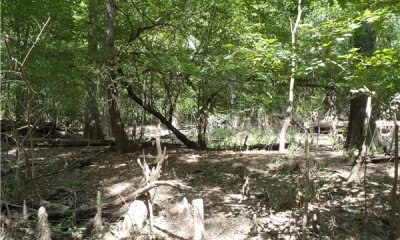
Poorly Drained Loamy Bottomland
Scenario model
Current ecosystem state
Select a state
Management practices/drivers
Select a transition or restoration pathway
-
Transition T1A
Introduction of non-native Chinese tallow
More details -
Transition T1B
harvested by clearcut and planted to a monoculture of hardwood trees
More details -
Restoration pathway R2A
Chemical and/or mechanical control of Chinese tallow
More details -
Transition T2A
Harvested by clearcut and planted to a monoculture of hardwood trees
More details -
Restoration pathway R3A
selective harvest coupled with reintroduction of native species
More details -
No transition or restoration pathway between the selected states has been described
Target ecosystem state
Select a state
Description
The Poorly Drained Loamy Bottomland ecological site is a Willow Oak/Water Oak Forest. The deep loamy soils are poorly drained and support hydrophytic vegetation. The overstory is moderate to heavy from 75 to 95 percent canopy cover. The basal areas are high, from 80 to over 100 square feet per acre. Fire is infrequent, occurring at intervals greater than 20 years apart, typically when lengthy dry periods occur. The dominant force in shaping the ecosystem is the flooding regimes. When flooding saturates the soil, water does not allow oxygen to flow through the soil, causing anoxic conditions. Some soil indicators include: gleyed (grey) colors with redoximorphic features (reds and yellow intermixed) and manganese nodules. The understory vegetation has adapted to the seasonally anaerobic conditions and are dominant. The USACOE classifies plants that occur in wetlands with an estimated probability greater than 99 percent obligate (OBL), and those 67 to 99 percent facultative wetland (FACW) plants. Facultative wetland plants are the most common encountered throughout the bottomlands, with obligate plants found in the longer flooded areas and facultative wetland plants found on the peripheries.
Submodel
Description
Chinese tallow (Triadica sebifera) is an undesired, invasive species brought to the United States in 1776 (Randall and Marinelli, 1996). Rapid expansion along the gulf coastal states has allowed the species to invade many ecosystems and consequently reduce diversity. Tallow trees are known to cause gastrointestinal upset, contact dermatitis, and toxicity in livestock and humans. Mechanical and chemicals options exist as a means to control the trees.
Submodel
Mechanism
The transition from State 1 to State 2 is a result of occupancy by Chinese tallow or other noxious weeds. Invasive plants outcompete, and eventually choke out, all other native species.
Mechanism
The transition is due to the land manager maximizing silviculture potential. Merchantable timber is harvested by clearcut. Then, the site is prepared and planted to a monoculture of hardwood trees.
Mechanism
The driver for restoration is control of Chinese tallow. Although an option, mechanical removal of the trees is difficult because they readily regrow from roots and seeds. Several chemicals methods are available including glyphosate for cut-stump treatments, triclopyr for cut-stump and foliar treatments, imazamox for broad spectrum application, and imazapyr as a foliar spray. Many aquatic herbicides have water use restrictions and can potentially kill hardwoods, so labels and restrictions should be read carefully prior to application.
Mechanism
The transition is due to the land manager maximizing silviculture potential. Merchantable timber is harvested by clearcut, the site prepared and planted to a monoculture of hardwood trees.
Mechanism
This restoration pathway may be accomplished by removing unwanted overstory trees (if present) and replanting bottomland hardwoods. Restoration efforts for bottomland hardwood forests have proven difficult and much research has been done on these ecosystems. Many times restoring the function of the ecosystem is the most difficult obstacle. Evapotranspiration and hyrdoperiod are closely linked and may never fully be restored until a forested condition exists again (Stanturf et al., 2001).
Local tree availability may limit the possibilities of species composition. Careful planning of available species, site design, and further management actions should be conversed with a knowledgeable restoration source. With this in mind, oftentimes late summer and early fall are the best times to begin due to possibly wet conditions during the late fall to early spring. Many detailed guides have been written to assist with restoration, and suggested readings include, “A Guide to Bottomland Hardwood Restoration” (Allen et al., 2001).
Model keys
Briefcase
Add ecological sites and Major Land Resource Areas to your briefcase by clicking on the briefcase (![]() ) icon wherever it occurs. Drag and drop items to reorder. Cookies are used to store briefcase items between browsing sessions. Because of this, the number of items that can be added to your briefcase is limited, and briefcase items added on one device and browser cannot be accessed from another device or browser. Users who do not wish to place cookies on their devices should not use the briefcase tool. Briefcase cookies serve no other purpose than described here and are deleted whenever browsing history is cleared.
) icon wherever it occurs. Drag and drop items to reorder. Cookies are used to store briefcase items between browsing sessions. Because of this, the number of items that can be added to your briefcase is limited, and briefcase items added on one device and browser cannot be accessed from another device or browser. Users who do not wish to place cookies on their devices should not use the briefcase tool. Briefcase cookies serve no other purpose than described here and are deleted whenever browsing history is cleared.
Ecological sites
Major Land Resource Areas
The Ecosystem Dynamics Interpretive Tool is an information system framework developed by the USDA-ARS Jornada Experimental Range, USDA Natural Resources Conservation Service, and New Mexico State University.
